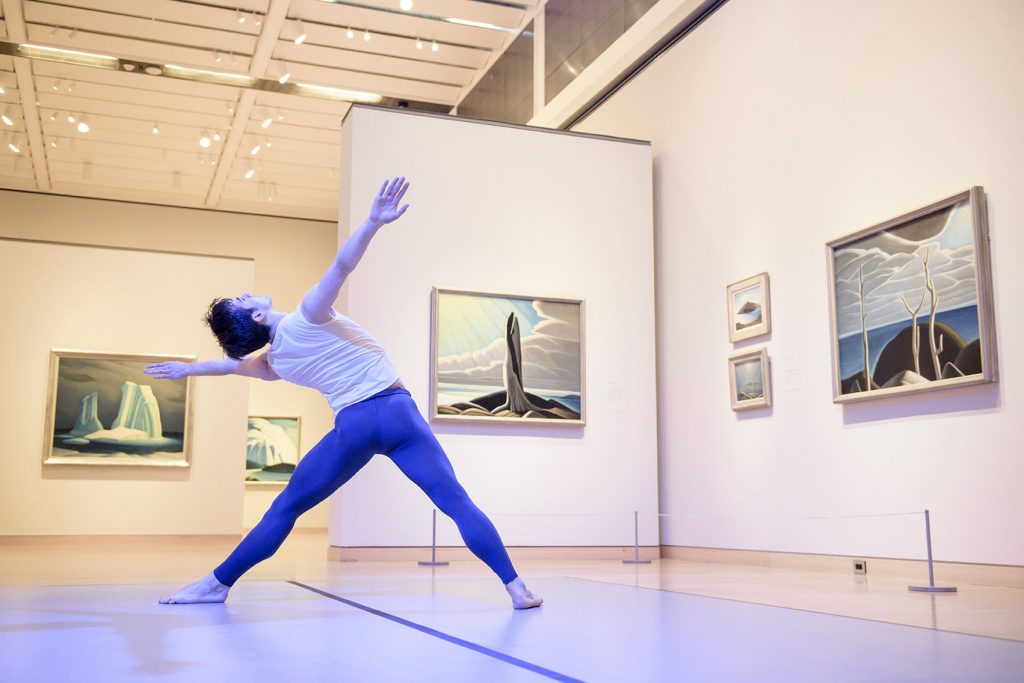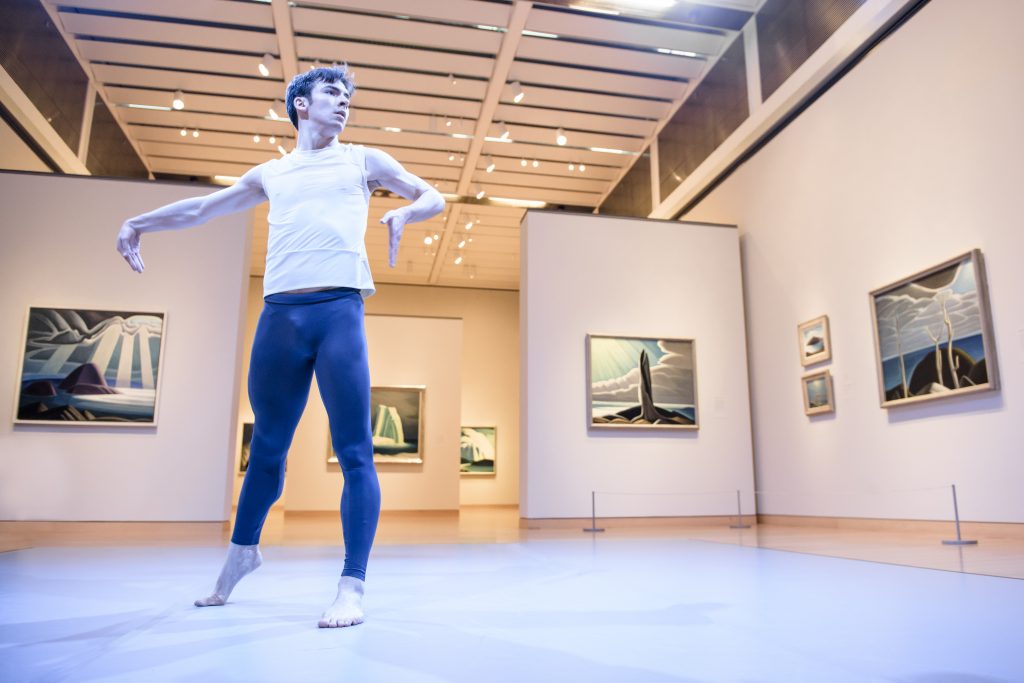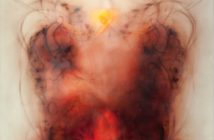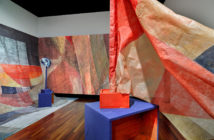A gray dance floor is stationed in the middle of the Museum of Fine Art’s exhibit The Idea of North: The Paintings of Lawren Harris. Its pale color complements the light blue and white hues of Harris’s paintings, which boldly depict the natural landscapes of Lake Superior and the snow-capped Rocky Mountains.
Spencer Hack (corps de ballet member of the National Ballet of Canada) walks onto the dance floor to perform the seven-minute solo titled Lake Maligne, choreographed by Robert Binet (choreographic associate of the National Ballet of Canada). Spencer begins the solo by slowly extending his arms, fingers outstretched above his head as he bends his torso to the left. He melts from this stance and compresses inward towards his knees before assuming this outstretched posture once again. Two of Harris’s paintings frame Spencer’s body, making him seem an embodiment of the represented trees.

Spencer Hack, Lake Maligne, choreographed by Robert Binet, The Idea of North: The Paintings of Lawren Harris, Museum of Fine Arts, Boston, 2016. Image Credit: Liza Voll Photography.
Spencer’s dance continues, calling to mind the paintings of nature that surround him. His movement evolves from phrases evoking the dynamics of trees swaying in the wind, waterfalls causing ripples in a stream, and the percussive pecking and unease of birds rummaging for food. As Spencer travels around the space, one question comes to mind: Does staging a dance performance in an art exhibit enhance audience members’ engagement with the paintings?
The relevance of this question stems from the MFA’s initiative—begun in 2013—to bring conventional art exhibits to life and explore one medium of art through another (in this instance, Harris’s paintings through Binet’s choreography). Spencer’s movement certainly activates the paintings. As he dances through the space, the paintings act as backdrops that seem in conversation with his changing postures. Even though the choreography does not literally translate the paintings into dance, it responds to the paintings and embodies the mood that the paintings inspire. For instance, for several moments, Spencer’s movement reads as feeling minuscule in the expanse of the natural landscape that Harris depicts. This feeling didn’t surface for me as I observed the paintings before the performance, but as I watched Spencer dance I began to imagine how one would feel in the vast landscapes that Harris depicts. The choreography encouraged a heightened connection to and deeper understanding of the paintings and the feelings that they capture.
The choices for the lighting and music of the performance also created an atmosphere that brought the paintings to life and created an immersive experience for the audience. The first track of the recorded music is instrumental and calls to mind a primordial setting where the expansiveness of nature is unhindered and creatures exist without human intervention. This track is complemented by choreography that propels Spencer’s energy outward, such as the gooey backbend with his right leg extending outward and towards his left ankle, or in technical terms: the cambré derrière with his right leg traveling from à la seconde to a coupé derrière.

Spencer Hack, Lake Maligne, choreographed by Robert Binet, The Idea of North: The Paintings of Lawren Harris, Museum of Fine Arts, Boston, 2016. Image Credit: Liza Voll Photography.
The second track is by American singer Bill Callahan. It begins with the staccato strumming of an acoustic guitar that Spencer embodies through percussive and more upbeat movement. This shift in choreography ushers in the shift to Spencer’s more anxious energy that gives off the feeling of unease and being lost. The phrase “Winter weather is not my soul” brings the track from its guitar introduction into lyrics that depict natural landscapes and birds flying in the breeze (“Like I’m a southern bird that stayed north too long”). The lyrics of this track compliment the natural landscapes in Harris’s paintings and provide another means for the audience to journey into the paintings. The lyrics continue with the phrase “Why is everybody looking at me like there’s something fundamentally wrong?” These feelings of inadequacy are embodied by the multiple moments that bring Spencer from rapid movement phrases into abrupt stops as he looks around anxiously and confusedly.
In exquisite movement, Spencer travels from corner to corner of the space glazed in a violet light that complements the blue hues of Harris’s lakes and icy mountains. At select moments, the lighting shifts to an orange hue that calls to mind the sun pouring in through the clouds in Harris’s paintings. In essence, the movement, music, and lighting that fill the exhibit encourage a new reading of the paintings and bring them to life.
The engagement that the performance had on Harris’s work was facilitated by a question and answer session with the choreographer and the dancer immediately following the performance. This session provided a bridge between audience member and artist, between what was experienced in the solo performance and the creative process and thinking behind it. This discussion section was insightful because it created the space for audience members to learn that Binet was inspired by Harris’s paintings because “[Harris] takes nature and abstracts it in such a way as to show us its [...] internal energies, its life force, its spirit.” This sentiment was reflected in the nature-evoking movement that Spencer performed. Another moment of insight into the performance was Binet’s answer to his choice of the second piece of music: “Something that has always struck me in Harris’s work is that you feel [...] so small in something so fearsome and so large.” This parallels the feelings of unease and anxiety in Spencer’s frantic movement.
Spencer ends the piece walking offstage and towards a painting of the Rocky Mountains as if he had just stepped out of the painting to bring its dynamics to life and is returning to his abode. With this visual in mind, I sense that the MFA’s initiative to bring its paintings to life by adding the dimension of performance art, such as dance, is both an innovative idea in enhancing the museum experience and a great success in its implementation. The success of the project is not from the mere livening up of the traditionally static museum exhibition through a choreography that activates the space. Rather, the success derives from the creation of a choreography that is site-specific and adds another dimension to the works on display. Binet’s choreography leads viewers to engage with Harris’s paintings in a new and invigorating way that they would not have had they just observed the paintings. Such pairings are the new frontier of the museum experience, and they are upon us in Boston.




